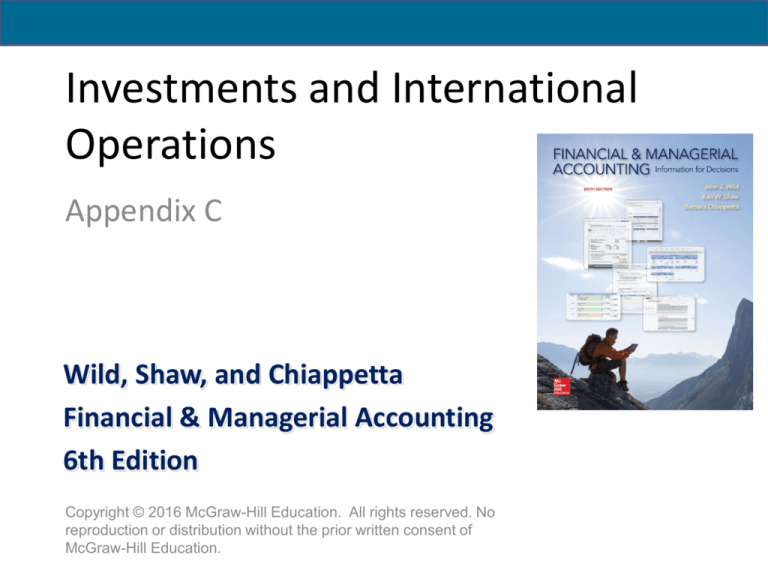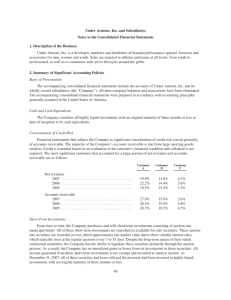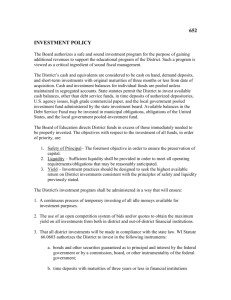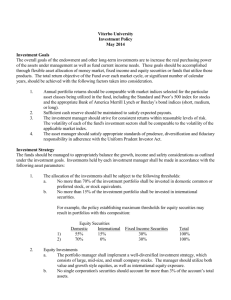
Investments and International
Operations
Appendix C
Wild, Shaw, and Chiappetta
Financial & Managerial Accounting
6th Edition
Copyright © 2016 McGraw-Hill Education. All rights reserved. No
reproduction or distribution without the prior written consent of
McGraw-Hill Education.
C-C1: Basics of Investments
2
Basics of Investments
Motivation for Investments
1.Companies transfer excess cash into
investments to produce higher income.
2.Some companies are set up to
produce income from investments.
3.Companies make investments for
strategic reasons.
C1
3
Investments of Selected
Companies
Short-Term (S-T) and Long-Term (L-T)
Investments as a Percent of Total Assets
C1
4
Short-Term Investments
Short-term investments are securities that:
• Management intends to convert to cash within
one year or the operating cycle, whichever is
longer.
• Are readily convertible to cash.
Short-term investments do not include cash
equivalents. Cash equivalents are investments that
are both readily converted to known amounts of cash
and mature within three months.
C1
5
Long-Term Investments
Long-term investments:
• are not readily convertible to cash.
• are not intended to be converted to cash
in the short term.
• are reported in the noncurrent section of
the balance sheet, often in its own
category.
C1
6
Debt Securities versus
Equity Securities
Debt Securities
• Reflect a creditor relationship
• Examples: Investments in notes, bonds, and CDs
• May be issued by governments, companies, or individuals
Equity Securities
• Reflect an owner relationship
• Examples: Investments in shares of stock
• Issued by companies
C1
7
Classification and Reporting
Accounting for Investments depends on three factors:
1. Security type: debt or equity
2. Intent to hold the security short or long term
3. Percentage ownership in another company’s equity securities
C1
8
Debt Securities: Accounting Basics
Debt securities are recorded at cost when
purchased. Interest revenue for investments in debt
securities is recorded when earned.
On September 1, 2014, Music City paid $29,500 plus a
$500 brokerage fee to buy Dell’s 7%, 2-year bonds payable
with a $30,000 par value. The bonds pay interest
semiannually on August 31st and February 28th. Music City
plans to hold the bonds until they mature (HTM securities).
C1
9
Debt Securities: Accounting Basics
Interest earned but not received must be
accrued on December 31, 2014.
$30,000 par value × 7% × 4/12 = $700 interest earned.
C1
10
Debt Securities: Accounting Basics
On February 28, 2015, Music City will record the
receipt of the semiannual interest. The company’s
accountants will make the following entry.
$30,000 par value × 7% × 6/12 = $1,050 (Interest received).
$30,000 par value × 7% × 4/12 = $700 (Interest earned in 2012).
$30,000 par value × 7% × 2/12 = $350 (Interest earned in 2013).
C1
11
Debt Securities: Accounting Basics
When the bonds mature, Music City will
receive the amount of the par value in cash.
The bonds have now been retired.
P2
12
Equity Securities:
Accounting Basics
Equity securities are recorded at cost when
acquired, including commissions or brokerage fees
paid. Any cash dividends received are credited to
Dividend Revenue and reported in the income
statement. When the securities are sold, sales
proceeds are compared with cost, and any gain or
loss is recorded.
C1
13
Equity Securities:
Accounting Basics
On December 20, Music City sells 500 shares of
Intex in the open market for $45,000.
Calculate original cost per share:
$86,000 ÷ 1,000 shares = $86.00 per share cost.
Calculate cost of shares sold:
500 shares × $86 = $43,000.
C1
14
C-P1: Reporting of
Noninfluential Investments
15
Reporting of Noninfluential
Investments
Companies must value and report most
noninfluential investments at fair value. The exact
reporting requirements depend on whether the
investments are classified as (1) trading, (2) heldto-maturity, or (3) available-for-sale.
P1
16
Trading Securities
1. Debt and equity securities
2. Actively managed and traded for profit
3. Frequent purchases and sales expected
4. Reported at fair value
5. Unrealized gain or loss reported in the income
statement
P1
17
Trading Securities
TechCom’s portfolio of trading securities had a total cost of
$11,500, and a fair value of $13,000, on December 31, 2014,
the first year the securities were held. The $1,500 difference
between the cost of $11,500 and the fair value of $13,000 is an
unrealized gain.
P1
18
Trading Securities
Assume TechCom sells trading securities that had cost
$1,000 for $1,200 cash, on January 9, 2015.
The gain is reported in the Other
Revenues and Gains section of the
Income Statement. Likewise, a loss
would be reported in Other
Expenses and Losses section.
P1
19
NEED-TO-KNOW
Berkshire Co. purchases investments in trading securities at a cost of $130 on December 15, 20X1. (This is its first
and only purchase of such securities.) On December 28, Berkshire received a $15 cash dividend from the stock
purchased on December 15. At December 31, 20X1, the trading securities had a fair value of $140.
a. Prepare the December 15 acquisition entry for the trading securities’ portfolio.
b. Prepare the December 28 receipt of cash dividends entry for the trading securities’ portfolio.
20X1
Dec. 15
Dec. 28
General Journal
Short-term investments - Trading
Cash
Cash
Dividend revenue
Debit
130
Credit
130
15
15
Short-term investments - Trading
Dec. 15
130
P1
20
NEED-TO-KNOW
Berkshire Co. purchases investments in trading securities at a cost of $130 on December 15, 20X1. (This is its first
and only purchase of such securities.) On December 28, Berkshire received a $15 cash dividend from the stock
purchased on December 15. At December 31, 20X1, the trading securities had a fair value of $140.
a. Prepare the December 15 acquisition entry for the trading securities’ portfolio.
b. Prepare the December 28 receipt of cash dividends entry for the trading securities’ portfolio.
c. Prepare the December 31 year-end adjusting entry for the trading securities’ portfolio.
Short-term investments - Trading
Dec. 15
130
Dec. 31
130
Fair value adjustment - Trading
Unadjusted
0
Adjustment
10
Adjusted
10
Step 1: Determine what the current account balance equals.
Step 2: Determine what the current account balance should equal.
Step 3: Record an adjusting entry to get from step 1 to step 2.
20X1
Dec. 31
P1
General Journal
Fair value adjustment - Trading
Unrealized gain - Income
$0
$10
$10
Debit
10
Credit
10
21
NEED-TO-KNOW
Berkshire Co. purchases investments in trading securities at a cost of $130 on December 15, 20X1. (This is its first
and only purchase of such securities.) On December 28, Berkshire received a $15 cash dividend from the stock
purchased on December 15. At December 31, 20X1, the trading securities had a fair value of $140.
a. Prepare the December 15 acquisition entry for the trading securities’ portfolio.
b. Prepare the December 28 receipt of cash dividends entry for the trading securities’ portfolio.
c. Prepare the December 31 year-end adjusting entry for the trading securities’ portfolio.
d. Explain how each account in entry c) is reported in financial statements.
Short-term investments - Trading
Dec. 15
130
Dec. 31
130
20X1
Dec. 31
General Journal
Fair value adjustment - Trading
Unrealized gain - Income
Balance Sheet
Current assets:
Short-term investments - Trading
Fair value adjustment - Trading
Short-term investments - Trading (at fair value)
P1
Fair value adjustment - Trading
Unadjusted
0
Adjustment
10
Adjusted
10
Debit
10
Credit
10
$130
10
$140
Income Statement
Other revenues and gains:
Dividend revenue
Unrealized gain - Income
$15
10
22
NEED-TO-KNOW
Berkshire Co. purchases investments in trading securities at a cost of $130 on December 15, 20X1. (This is its first
and only purchase of such securities.) On December 28, Berkshire received a $15 cash dividend from the stock
purchased on December 15. At December 31, 20X1, the trading securities had a fair value of $140.
a. Prepare the December 15 acquisition entry for the trading securities’ portfolio.
b. Prepare the December 28 receipt of cash dividends entry for the trading securities’ portfolio.
c. Prepare the December 31 year-end adjusting entry for the trading securities’ portfolio.
d. Explain how each account in entry c) is reported in financial statements.
e. Prepare the January 3, 20X2, entry when a portion of its trading securities (that had originally cost $33) is
sold for $36.
Short-term investments - Trading
Dec. 31
130
Jan. 3
33
Jan. 3
97
20X2
Jan. 3
P1
Fair value adjustment - Trading
Dec. 31
10
General Journal
Cash
Short-term investments - Trading
Gain on sale of short-term investments
Debit
36
Credit
33
3
23
C-P2: Held-to-Maturity
Securities
24
Held-to-Maturity Securities
1. Debt securities
2. Intent and ability to hold until maturity
3. Reported as:
a) Current assets if their maturity dates are within
one year or the operating cycle, whichever is
longer.
b) Noncurrent investments if their maturity dates
are longer than one year or the normal
operating cycle, whichever is longer.
P2
The portfolio of HTM securities is
reported at amortized cost. There is no
fair value adjustment to the portfolio.
25
NEED-TO-KNOW
Prepare journal entries to record the following transactions involving the short-term securities
investments of LA Life.
a. On May 14, paid $100 cash to purchase Muni’s 90-day short-term debt securities ($100 principal), dated
May 14, that pay 8% interest (categorized as held-to-maturity securities).
b. On August 12, received a check from Muni in payment of the principal and 90 days’ interest on the debt
securities purchased in transaction a.
May. 14
Aug. 12
P2
General Journal
Short-Term Investments - HTM (Muni)
Cash
Cash
Interest revenue
($100 x .08 x 90/360)
Short-Term Investments - HTM (Muni)
Debit
100
Credit
100
102
2
100
26
C-P3: Available-for-Sale
Securities
27
Available-for-Sale Securities
1. Debt and equity securities not classified as trading or
held-to-maturity
2. Not actively managed
3. Report as:
a) Short-term investments if the intent is to sell the
securities within one year or the normal operating
cycle, whichever is longer.
b) Long-term investments if securities do not meet
short-term investment criteria.
4. Valued at fair value
5. Unrealized gains or loss reported in the equity section of
the balance sheet as part of comprehensive income
P3
28
Available-for-Sale Securities
Music City had no prior investments. In the current
period, it acquired two available-for-sale securities.
At December 31, 2014, the following information is
provided:
P3
29
Available-for-Sale Securities
Music City
Partial Balance Sheet
December 31, 2014
Assets
Long-term investments‒AFS (at cost)
Fair value adjustment–AFS
Long-term investments‒AFS (at fair value)
Equity
Add unrealized gain on AFS securities
P3
$ 73,000
1,550
$ 74,550
$ 1,550
30
Available-for-Sale Securities
Let’s extend our example and assume that at December
31, 2015, the portfolio of long-term AFS securities has an
$81,000 cost and an $82,000 fair value.
P3
31
Global View
Fair Value Option for Reporting Financial Assets
Both U.S. GAAP and IFRS permit companies to use fair
value in reporting financial assets. This option allows
companies to report any financial asset at fair value and
recognize value changes in income. This method was
previously reserved only for trading securities, but now is
an option for available-for-sale and held-to-maturity
securities.
32
NEED-TO-KNOW
Gard Company completes the following selected transactions related to its short-term investments
during the current year. Prepare journal entries to record the following transactions.
May 8 Purchased 300 shares of FedEx stock as a short-term investment in availablefor-sale securities at $40 per share plus $975 in broker fees.
Sep. 2 Sold 100 shares of its investment in FedEx stock at $47 per share and held the
remaining 200 shares; broker’s commission was $225.
Oct. 2 Purchased 400 shares of Ajay stock for $60 per share plus $1,600 in
commissions. The stock is held as a short-term investment in available-for-sale
securities.
P3
33
NEED-TO-KNOW
May 8 Purchased 300 shares of FedEx stock as a short-term investment in availablefor-sale securities at $40 per share plus $975 in broker fees.
Sep. 2 Sold 100 shares of its investment in FedEx stock at $47 per share and held the
remaining 200 shares; broker’s commission was $225.
Oct. 2 Purchased 400 shares of Ajay stock for $60 per share plus $1,600 in
commissions. The stock is held as a short-term investment in available-for-sale
securities.
May 8
Sep. 2
Oct. 2
General Journal
Short-term investments - AFS (FedEx)
Cash
(300 x $40) + $975
Credit
12,975
Cash
(100 x $47) - $225
Short-term investments - AFS (FedEx) ($12,975 x 100/300)
Gain on sale of short-term investment
Short-term investments - AFS (Ajay)
Cash
Debit
12,975
(400 x $60) + $1,600
4,475
4,325
150
25,600
25,600
Short-Term Investments - AFS
May 8
12,975
Sep. 2
4,325
Oct. 2
25,600
Dec. 31
34,250
P3
34
NEED-TO-KNOW
Prepare an adjusting journal entry as of December 31, 20X1, if the fair values of the equity securities
held by Gard Company are $48 per share for FedEx and $55 per share for Ajay. (Year 20X1 is the
first year Gard Company acquired short-term investments.)
Short-Term Investments - AFS
May 8
12,975
Sep. 2
4,325
Oct. 2
25,600
Dec. 31
34,250
Shares
FedEx
Ajay
Dec. 31
P3
200
400
Cost per
share
$43.25
$64.00
Fair Value Adjustment (AFS-ST)
0
Total cost Fair Value Total Fair
per Share
Value
$8,650
25,600
$34,250
$48.00
$55.00
$9,600
22,000
$31,600
General Journal
Unrealized Loss - Equity
Fair Value Adjustment - Available-for-Sale (ST)
Adj.
Dec. 31
2,650
2,650
Debit
2,650
Credit
Unrealized
Gain (Loss)
($2,650)
2,650
35
C-P4: Reporting of Influential
Investments
36
Accounting For Influential
Investments
Investor Ownership of
Investee Shares Outstanding
Cost or
Market
Value
Method
0%
P4
Equity
Method
20%
Consolidated Financial
Statements
50%
100%
In some cases, influence or control may
exist with less than 20% ownership.
37
Accounting For Influential
Investments
Investor Ownership of
Investee Shares Outstanding
Cost or
Market
Value
Method
0%
P4
Equity
Method
20%
Consolidated Financial
Statements
50%
100%
Significant influence is generally
assumed with 20% to 50% ownership.
38
Investments in Equity Securities
with Significant Influence
Original investment is recorded at cost.
The investment account is increased by a
proportionate share of investee’s earnings.
The investment account is decreased by dividends
received.
P4
39
Investments in Equity Securities
with Significant Influence
On January 1, 2014, Micron Co. records the
purchase of 3,000 shares (30%) of Star Co. common
stock at a total cost of $70,650 cash.
P4
40
Investments in Equity Securities
with Significant Influence
For 2014, Star reports net income of $20,000, and
pays total cash dividends of $10,000 on January 9,
2015.
$20,000 × 30% = $6,000
P4
$10,000 × 30% = $3,000
41
Investments in Equity Securities
with Significant Influence
P4
42
C-C2: Investment in
Securities with Controlling
Influence
43
Investments in Securities
with Controlling Influence
Required when investor’s ownership exceeds
50% of investee.
Equity Method is used.
Consolidated financial statements show the
financial position, results of operations, and
cash flows of all entities under the parent’s
control.
C2
44
Accounting Summary for
Investments in Securities
C2
45
Comprehensive Income
Comprehensive Income: all changes in equity during a period
except those from owners’ investments and dividends.
Examples of items not included in Net Income but which are part of
Comprehensive Income include:
Unrealized gains and losses on available-for-sale securities
Foreign currency adjustments
Certain pension adjustments
Comprehensive Income Reporting Options
1. On a separate statement of comprehensive income that immediately
follows the income statement.
2. On the lower section of the income statement (as a single continuous
statement of income and comprehensive income).
C2
46
Global View
Accounting for Noninfluential Securities
The accounting for noninfluential securities is broadly similar
between U.S. GAAP and IFRS. There are a couple of differences
in terminology. Trading securities are referred to in IFRS as
financial assets at fair value though profit and loss, and availablefor-sale securities are referred to as available-for-sale financial
assets.
Accounting for Influential Securities
The accounting for influential securities is broadly similar between
U.S. GAAP and IFRS. There are a couple of minor differences in
terminology.
47
C-A1: Components of Return
on Total Assets
48
Components of
Return on Total Assets
Return on
total assets
Net income
Average total assets
A1
=
=
Profit
margin
Net income
Net sales
Total asset
turnover
×
×
Net sales
Average total assets
49
Return on Total Assets
Here are the returns on total assets for Gap, Inc. for
the years 2010 through 20124:
* 2013 sales and income data scaled by 52/53 due to the 53-week year..
All companies desire a high return on total assets. To improve
the return, the company must meet any decline in profit margin
or total asset turnover with an increase in the other. Companies
consider these components in planning strategies.
A1
50
C-C3: Investments in
International Operations
51
Appendix C-A: Investments in
International Operations
Two major accounting challenges arise when
companies have international operations:
Accounting for sales
and purchases listed in
a foreign currency.
C3
Preparing consolidated
financial statements
with international
subsidiaries.
52
Exchange Rates Between
Currencies
Each country uses its own currency for internal
economic transactions.
To make transactions in another country, units
of that country’s currency must be acquired.
The cost of those currencies is called the
exchange rate.
C3
53
Sales in a Foreign Currency
Boston Company, a U.S.-based manufacturer makes a credit
sale to London Outfitters, a British retail company. On
December 12, 2014, Boston sells £10,000 of goods with
payment due on February 10, 2015. Boston keeps its record
in U.S. dollars. At the date of sale, the British pound is valued
at $1.80.
£10,000 × $1.80 = $18,000
C3
54
Sales in a Foreign Currency
Boston Company is a December 31, year-end company. On
December 31, 2014, the British pound has an exchange rate of
$1.84. The dollar value of the account receivable from London
is $18,400 on this date. The receivable is to be valued in the
balance sheet at its current dollar amount.
Accounts Receivable – London Outfitters
Date
Explanation
12/12/14 Sale
12/31/14 Adjustment for foreign currency
C3
Debit Credit
18,000
400
Balance
18,000
18,400
55
Sales in a Foreign Currency
On February 10, 2015, Boston receives London Outfitters’
payment of £10,000. Boston immediately exchanges the
pounds for U.S. dollars. The exchange rate on this date is
$1.78 per pound, so Boston receives $17,800 for the £10,000
received in settlement.
Accounts Receivable – London Outfitters
C3
Date
Explanation
12/12/14 Sale
12/31/14 Adjustment for foreign currency
2/10/15 Payment received
Debit
Credit Balance
18,000
18,000
400
18,400
18,400
-0-
56
Purchases in a Foreign Currency
NC Imports, a U.S. company, purchases
products costing €20,000 from Hamburg
Brewing on January 15, when the exchange
rate is $1.20 per euro.
€20,000 × $1.20 = $24,000
C3
57
Purchases in a Foreign Currency
NC Imports makes payment in full on February
14 when the exchange rate is $1.25 per euro.
€20,000 × $1.25 = $25,000
C3
58
Consolidated Statements with
International Subsidiaries
Consider a U.S.-based company that owns a controlling interest
in a French company. The reporting currency of the U.S.
company is the dollar. The French company maintains its books
in Euros. Before preparing consolidated statements, the U.S.
company must translate the French company’s statements into
dollars. The process requires the parent company to select
appropriate foreign exchange rates and to apply those rates to
the foreign subsidiary’s account balances.
Translate
C3
Account Balances
59
End of Appendix C
60







